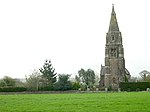HMS Raleigh (shore establishment)
Military of the United Kingdom in CornwallMilitary training establishments of the United KingdomRoyal Navy bases in EnglandRoyal Navy shore establishmentsTraining establishments of the Royal Navy ... and 2 more
Use British English from April 2016World War II sites in England

HMS Raleigh is a stone frigate (shore establishment), serving as the basic training facility of the Royal Navy at Torpoint, Cornwall, United Kingdom. It is spread over several square miles, and has damage control simulators and fire-fighting training facilities, as well as a permanently moored training ship, the former HMS Brecon. Its principal function is the delivery of both New Entry Training and Basic Training.
Excerpt from the Wikipedia article HMS Raleigh (shore establishment) (License: CC BY-SA 3.0, Authors, Images).HMS Raleigh (shore establishment)
Cedar Drive,
Geographical coordinates (GPS) Address Nearby Places Show on map
Geographical coordinates (GPS)
| Latitude | Longitude |
|---|---|
| N 50.3739 ° | E -4.2227 ° |
Address
HMS Raleigh
Cedar Drive
PL11 2QQ , Torpoint
England, United Kingdom
Open on Google Maps








